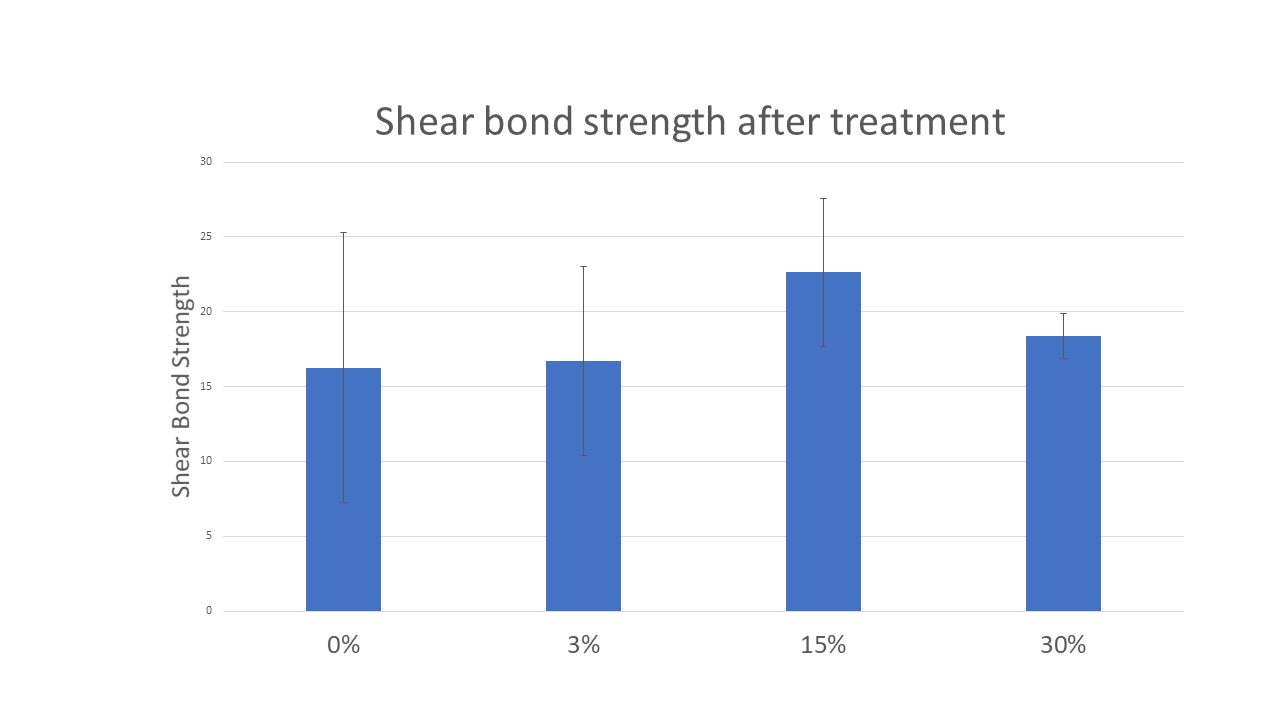IADR Abstract Archives
Shear Bond Strength of Dental Sealants After Hydrogen Peroxide Pretreatment
Objectives: This study compared the shear bond strength (SBS) of Helioseal F-plus pit-and-fissure sealant (Ivoclar Vivadent, Amherst, NY, USA) when applied following three hydrogen peroxide concentration pretreatments on enamel surfaces.
Methods: Twenty non-carious extracted human molars were embedded in acrylic with the enamel surface exposed. Each tooth was polished through 600 grit paper to achieve a flat enamel surface. Enamel surfaces were cleaned for 30 seconds with fluoride-free pumice using a rotary brush then rinsed with reverse osmosis (RO) water for 15 seconds, and air dried for 10 seconds. Samples were randomly divided into four groups (n=5/group) receiving one of the following: 0%, 3%, 15%, or 30% hydrogen peroxide scrubbed onto the enamel surface with a microbrush for 30 seconds. Samples were rinsed, air dried, and treated with 37% phosphoric acid for 30 seconds. After rinsing, Excite F bonding agent was applied to the etched enamel surface, gently air dried, and light-cured for 10 seconds. Sealant cylinders were created using an ultradent jig (Ultradent Products, South Jordan, UT) and cured for 30 seconds. Samples were stored in RO water (37°C/24hr). SBS was measured using an Instron E-3000 mechanical tester (Instron, Norwood, MA) at a cross speed of 0.5mm/min. Data were compared using ANOVA (post-hoc Tukey, alpha=0.05).
Results: There were no significant differences in the shear bond strength of Helioseal F-plus to enamel samples treated with any concentration of hydrogen peroxide compared to samples not treated with hydrogen peroxide.
Conclusions: Our results show that the application of hydrogen peroxide to enamel surfaces due to its bactericidal properties prior to sealant placement will not adversely affect the bond strength of the sealant to enamel.
Methods: Twenty non-carious extracted human molars were embedded in acrylic with the enamel surface exposed. Each tooth was polished through 600 grit paper to achieve a flat enamel surface. Enamel surfaces were cleaned for 30 seconds with fluoride-free pumice using a rotary brush then rinsed with reverse osmosis (RO) water for 15 seconds, and air dried for 10 seconds. Samples were randomly divided into four groups (n=5/group) receiving one of the following: 0%, 3%, 15%, or 30% hydrogen peroxide scrubbed onto the enamel surface with a microbrush for 30 seconds. Samples were rinsed, air dried, and treated with 37% phosphoric acid for 30 seconds. After rinsing, Excite F bonding agent was applied to the etched enamel surface, gently air dried, and light-cured for 10 seconds. Sealant cylinders were created using an ultradent jig (Ultradent Products, South Jordan, UT) and cured for 30 seconds. Samples were stored in RO water (37°C/24hr). SBS was measured using an Instron E-3000 mechanical tester (Instron, Norwood, MA) at a cross speed of 0.5mm/min. Data were compared using ANOVA (post-hoc Tukey, alpha=0.05).
Results: There were no significant differences in the shear bond strength of Helioseal F-plus to enamel samples treated with any concentration of hydrogen peroxide compared to samples not treated with hydrogen peroxide.
Conclusions: Our results show that the application of hydrogen peroxide to enamel surfaces due to its bactericidal properties prior to sealant placement will not adversely affect the bond strength of the sealant to enamel.

